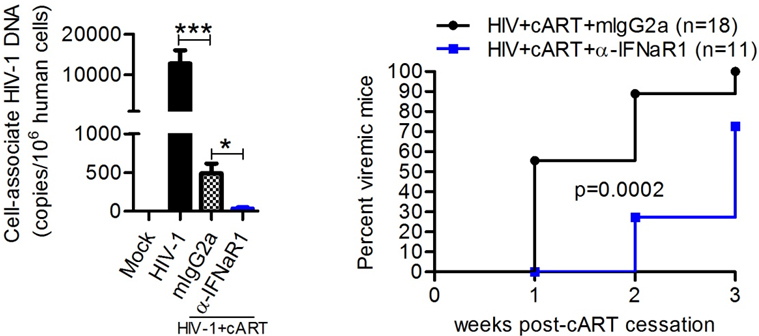


Blockade of typeⅠinterferon reduces HIV-1 reservoirs (Figure A) and delays viral rebound after cessation of antiretroviral therapy (Figure B).
On December 12, 2016, the Journal of Clinical Investigation published online the latest findings of a research team led by Zhang Liguo of the Institute of Biophysics of the Chinese Academy of Sciences (CAS) working in collaboration with Professor Su Lishan of the University of North Carolina. The article was titled "Blocking type I interferon signaling enhances T cell recovery and reduces HIV-1 reservoirs".
Type I interferon (IFN-I), an important antiviral factor, is a clinical treatment for virus infections including Hepatitis B and Hepatitis C. However, the role of IFN-I in HIV infection remains controversial, and clinical studies have yet to reveal any reliable effect despite some reports that it may efficiently suppress proliferation of HIV-infected cells. Therefore, IFN-1 has not been approved for HIV treatment to this day.
Zhang’s team has worked with Professor Su for a long time to analyze the roles of IFN-I in HIV infections and related mechanisms. A preliminary study they carried out proved that the pulp dendritic cell (pDC) was the major IFN-I generator. The researchers employed a specific antibody to delete the pDC in HIV-infected humanized mice. In this model, they discovered that the pDC was a double-edged sword – while inhibiting HIV replication, it also assisted the HIV in damaging the immune system. (PLOS Pathogens, 2014)
In the more recent study the researchers first developed a monoclonal antibody capable of blocking IFN-I signaling. They found that IFN-I signaling played a dual role of inhibiting HIV replication and damaging the immune system in HIV-infected humanized mice, which confirmed the results of the earlier pDC deletion experiment. Based on those findings, they proposed the following hypothesis: if IFN-I signaling is blocked during combined antiretroviral therapy (cART) for HIV, the blockade may reduce HIV-1 reservoirs and enhance the anti-HIV immune responses since cART can make up for the antiviral function of IFN-I signaling.
They confirmed that hypothesis using a monoclonal antibody to block IFN-I signaling. Blocking IFN-I signaling in the presence of cART can reduce the size of HIV reservoirs in the humanized mice (Figure A). After cART was ended, fast HIV-1 rebound was detected in the control group (mIgG2a) while the blockade group (α-IFNAR1) saw obviously delayed viral rebound (Figure B).
This study is relevant to clinical treatment of HIV in two ways:
1) Immune nonresponder patients. To the majority of HIV-infected patients, cART can effectively inhibit HIV replication. However, the immune systems of more than 20 percent of patients are persistently unable to recover. Those patients, called immune nonresponder patients, have a far higher risk of developing chronic diseases than immune responder patients, which is one of the thorniest problems faced by HIV treatment. Blocking IFN-I signaling may help with the immune recovery of immune nonresponder patients.
2) Functional cure for HIV. The ultimate goal of HIV treatment is to discover ways to effectively curb the viral reservoirs in HIV patients so that there will be no viral rebound (functional cure) after termination of the use of the antiviral drugs. Immunotherapy is one of the most important means of attaining a functional cure for HIV. Immunotherapies including the blockade of IFN-I signaling may be combined with other new technologies such as gene therapy or broadly neutralizing HIV-1 antibodies to achieve a functional cure for HIV.
Research Fellow Zhang Liguo at the Institute of Biophysics of the CAS and Professor Su Lishan of the University of North Carolina are the co-corresponding authors of this research. Postdoctoral Fellow Cheng Liang at Su’s laboratory and Ma Jianping, a doctoral student with Zhang’s research team, are the co-first authors. The Beijing Municipal Science and Technology Commission supported this project.
Source: Institute of Biophysics, CAS